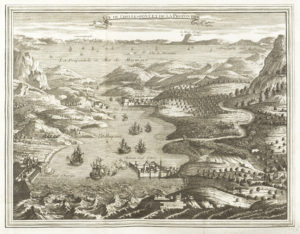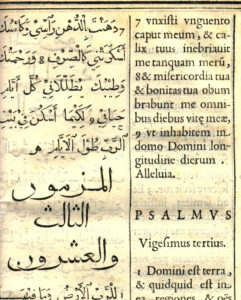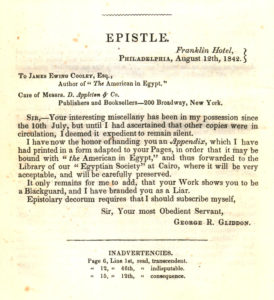
Illustration from a sketch of the ruins at Tadmor (Palmyra, Syria) by author Emily Beaufort Smythe (1861).
Middle East Studies in the West is informed by centuries of intellectual exchange that includes foundational works by Middle Eastern historians, language and cultural studies by European scholars, and popular travel writing by men and women who toured Egypt, Syria, Lebanon, Palestine, and Turkey in the 19th century. The Library’s exhibit, richly annotated by PSU alumnus and Middle East historian Gary Leiser, presents examples of works that contributed to the development of Middle East Studies in Europe, England, and the United States.
“Orientalism” in Academia and Printing

Map from Moeurs et usages des Turcs (1747).
French scholars coined the term “Orientalism” in the 18th century to describe the European scholarly study of the geographical region in which Arabic, Turkish, and Persian were spoken. For Europeans, this region began at the Eastern Mediterranean, where the Christian and Islamic worlds met.

Detail from the Psalms printed in Arabic and Latin by Francois Savary de Breves (1614).
Initially, Orientalism focused on translation, acquisition of scientific knowledge, and support of Christian missionary activities, but new approaches to texts and history broadened the field in the modern era. Book printers developed an Arabic typeface in the 16th century, and many Western scholars sought to consult (and publish) important Arabic works in the original. European universities promoted Middle Eastern studies by establishing academic chairs of Arabic. The exhibit features a printing of the first book set in Arabic type at Oxford (by the university’s first chair of Arabic), an edition of the Psalms in Arabic and Latin printed in France in 1614, and several examples of important works in printed Arabic written by Middle Eastern historians from the medieval era to the 18th century.
As European commercial and diplomatic relations with the Ottoman Empire and the Middle East in general expanded during the 18th and 19th centuries, study of the region developed as well and became increasingly secular, incorporating natural and cultural studies drawn from field research in addition to works on languages and religion.
Egyptology and Travel Literature

Letter to James Cooley from George Gliddon (1842).
In the 19th century, travel literature from the East gained popularity with the Western public. The new field of Egyptology also inspired tourism and spurred book sales. Popular Egyptologists in the exhibit include women like Amelia Edwards, whose journey up the Nile in 1873-4 inspired her life’s work of professional study and preservation of Egyptian antiquities, and Americans James Cooley and George R. Gliddon, who came to blows in New York City over Gliddon’s scathing refutation of Cooley’s poor scholarship and mockery of the American consulate in Egypt in 1842.
The materials selected for this exhibit are part of Special Collections’ Middle East Studies Collection, which originated with the founding of PSU’s Middle East Studies Center in 1959. The dynamism of the MESC made Portland State almost synonymous with Middle East Studies in the 1960s and 70s, especially with instruction in Arabic. As one of the ten federal depositories receiving materials from Egypt after 1961, the PSU Library built one of the best Arabic collections in the western U.S.
This essay is drawn in part from a sketch of the history of Middle East studies by historians Gary Leiser and John Mandaville.
Portland State University Library Special Collections thanks the Tarbell Family Foundation for supporting the ongoing development of the Middle East Studies collection.

